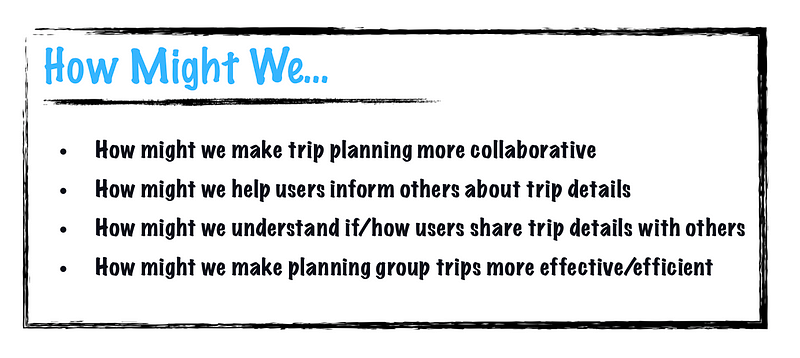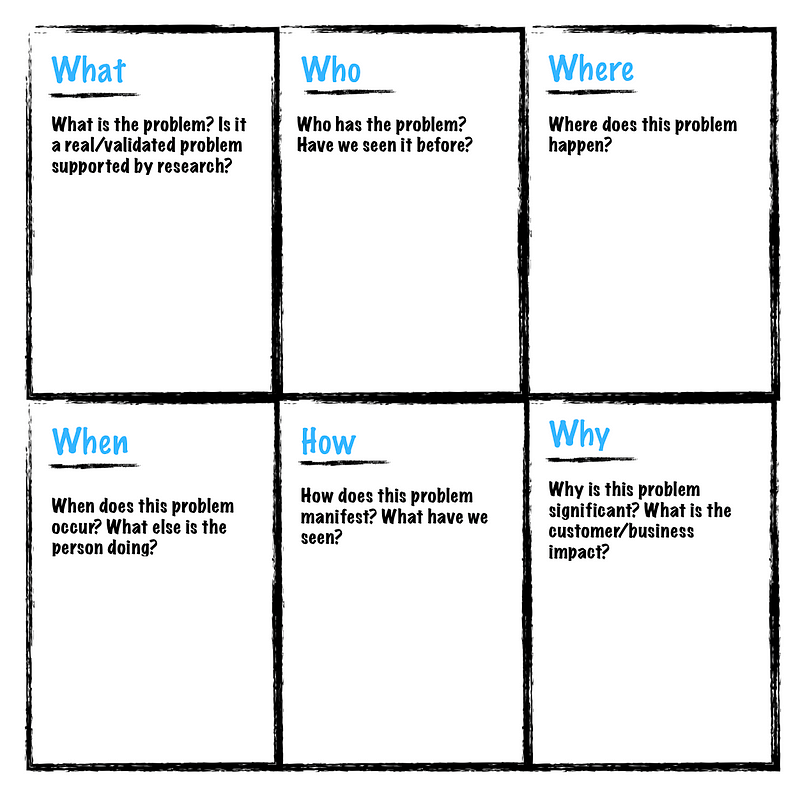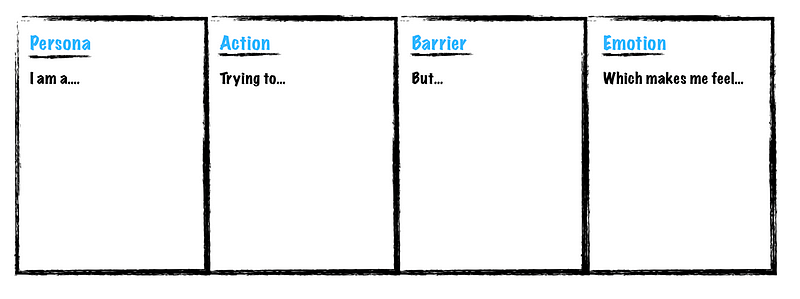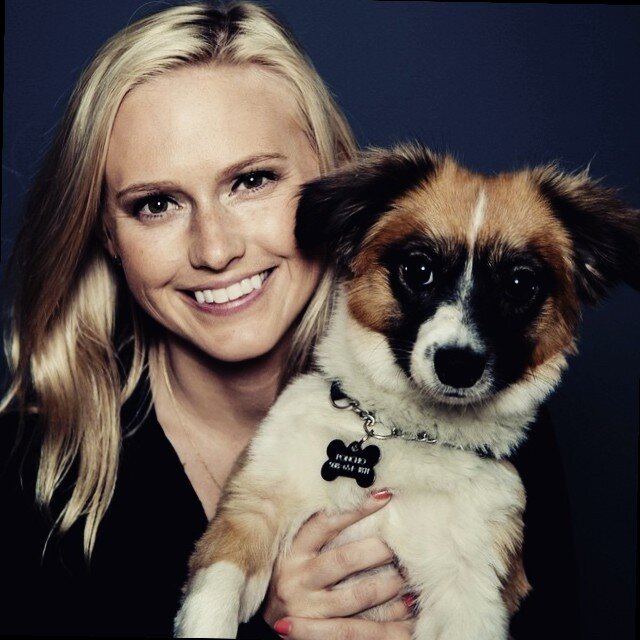5 ways to reframe a solution to a problem statement
And why this is essential for user research.

Very rarely do I get handed a problem statement. Whenever colleagues want to engage with me in a research project, they have already landed at a solution. I am not saying this is bad because solutions are a comfortable place to start. They are easy. However, they limit our potential and possibilities. I’ll give an example of something I hear frequently:
“We want to build a share feature for our users so they can share their trip ideas or details to friends and family. Can you research this for me?”
I’m sure this statement resonates with many user researchers. It is a tough situation to be in, and one that happens far too often. If this is the type of statement you are consistently getting from colleagues, you have an excellent opportunity to teach a new mindset. You can teach the mentality of approaching ideas from the problem-space before solution-space.
Why is reframing the solution important?
I’m going to pick on Google, for once, because I believe Google has enough self-confidence to take a small hit. Let’s talk about Google Glass.
To be upfront, Google Glass was a failure. The product did not succeed in the slightest. There are several different reasons for the flop, but we will focus on one in particular: Google Glass did not solve a problem for users.
There were many assumptions made about Google Glass, which were not validated with users. The conjectures led to many questions and, ultimately, to a product that did not correlate with the user’s needs or goals. There was a lack of clarity on:
- Who would use Google Glass
- When/where people would use Google Glass
- Why people would use Google Glass
- What value Google Glass brought to people
These are a lot of essential questions that were left unanswered. With this approach, there is a substantial likelihood that products will fail. If there is no value to users, they won’t use it.
And the best way to determine value? Start with a problem, not with a solution.
By understanding the problem-space before coming up with a solution, we allow for:
- Understanding a user’s actual problem and need
- Brainstorming ideas that are relevant for users
- More possibilities to help with a particular problem
- A higher likelihood of a successful product/feature
The best way to understand the problem space is by conducting generative research sessions with users. Although I won’t cover generative research here, please take a look at my comprehensive guide to generative research.
Picking apart the solution
We’ve established how important it is to start with a problem rather than a solution. However, many times, we are faced with a solution, as in the first example. Let’s take a look at that again:
“We want to build a share feature for our users so they can share their trip ideas or details to friends and family.”
Let’s assume there has not been any user research done on this topic of “sharing.” There are a few things that are not ideal with this statement:
- There is no clarity on what the problem is we are trying to solve
- We jump directly into a solution
- Users wanting to share their trip ideas or details is an assumption
- Sharing might not be the only or best solution
- Our thoughts should come from generative research
But, lets base this scenario in reality. We’ve received this solution and need to test it. We can go in one of two directions:
- Usability or concept test the solution
- Take a step back and consider the problem
I know the latter isn’t always possible, which is why I included the first option. Sometimes the idea/feature/product is too far down the production line, and we have to do damage control. The best we can do is usability test the solution to understand what we can improve in further iterations.
However, sometimes it isn’t too late, and we can take a step back and consider the problem. We can ask the question: “what problem is this solution trying to solve?”
Tools to reframe the solution -> problem statement
This kind of question may be much easier for researchers to think about since we are used to doing this daily. For our colleagues, it might not come as naturally. Luckily, there are a few different methods we can employ to help us reframe the solution.
‘How Might We’ (HMW) Statements
This method is very trendy in the UX world, and for a good reason. ‘How Might We’ statements allow us to reframe our insights and thoughts into a broader context. We use these types of statements because they can get us thinking about the problem from many different angles, and they open the door to creativity. They also ensure we are thinking about an actual user need versus just coming up with cool ideas. Let’s take the sharing example and recontextualize it with HMW statements:

Investigative Stories
Investigative stories enable us to become detectives when thinking about a problem. With this method, you employ a journalist-type view of the situation. By looking into all of the different aspects of the problem, you can get a holistic picture of what you are trying to tackle. After you answer all of the questions, you can create a story of your user, which helps to understand the actual user need/problem.

Unpacking Assumptions
This is a technique I have been practicing and teaching for many years now. It is one of my favorites as it plays very well into my Buddhism practice. Before I begin thinking about solutions, I list all of the different assumptions I/we have about the user. It consists of everything you think you know. If we take the example above, the list might look like this:
- Users want to share trip details with friends and family
- Users are booking travel for a group of people
- Users need other’s opinions on their trip options/details
- Users find their current method of sharing details painful
- Users want a new way to share trip details with others
The Six Thinking Hats Model
Dr. Edward de Bono originally introduced the ‘Six Thinking Hats’ model. This method examines problems/concepts from many different viewpoints to get a holistic understanding. Getting colleagues to engage in this kind of exercise can be complicated, but also extremely rewarding. The thinking hats/roleplaying game gets people into the minds of users. Each person wears a hat:
- White hat: Facts
- What information do we have?
- What hasn’t worked in the past?
- What information is missing that we need?
- What are the weaknesses? - Green hat: Creativity
- What are the other angles we are missing?
- What are the alternatives?
- What are the next steps? - Yellow hat: Benefits
- What are all the benefits of the different options?
- What solutions would work?
- What is the best-case scenario (for users and the business)? - Black hat: Risk
- What are the different risks of each option?
- What solutions would not work?
- What is the worst-case scenario (for users and the business)? - Red hat: Feelings
- How do the options make you feel (from the user’s perspective)?
- What do you like about the options?
- What don’t you like about the options? - Blue hat: Process
- Where are we now?
- What other work needs to be done?
- What is the next step?
Research Plan Template
One of the most significant pieces of advice I can give is to create a template that prompts colleagues to think of the problem statement before they even come to you. An additional way I do this is by sending a research plan template for colleagues to fill out before we meet to discuss features. This template starts with the problem we are trying to tackle, rather than the solution. With this, you can start discussions from the problem-space. Check out my research plan template.
Writing the problem statement
Once you have done these exercises, you can write some problem statements. I mentioned the ‘How Might We’ formula above, but I also use some other problem statement formulas:
- I am (persona/role) trying to (do X) but (barrier/problem) because (x), which makes me feel (emotion)
- I am a mom trying to book a flight ticket home for my daughter, but I don’t know her college schedule, so I am unsure which dates to book for her, which makes me feel frustrated.
- I am (a persona/in a situation) who needs a way to (user need) because (current problem)
- I am traveling with a group of friends and need a way to coordinate everyone’s schedules so that I can pick the best date/time for everyone

You don’t have to use the exact formula (I deviated above), but it is an excellent framework to keep in mind. Try to avoid proposing solutions during this phase, as it is an easy trap to fall into. Keep your focus on the problem and facts.
Overall, getting people to shift from the solution-space to the problem-space is a considerable challenge, but one worth confronting. If you are continually urging others to think about the problem before the solution, they will start to adapt to that mindset. By instilling these practices, and with some time, you can transform the mindset of an organization to approach ideas from the problem-space. Not only does this make your life as a user researcher easier, but it also turns the company into a much more user-centric culture.
If you liked this article, you may also find these interesting:
- User Research isn’t black & white
- How to write a generative research interview guide
- Benefits of internal user research
- User research plans — with template
Interested in more user research? I teach an Introduction to User Research Course and am available for one-on-one mentoring. Check out the User Research Academy.
Please join the User Research Academy Slack Community for more updates, postings, and Q&A sessions
